engine TOYOTA YARIS 2019 Owners Manual (in English)
[x] Cancel search | Manufacturer: TOYOTA, Model Year: 2019, Model line: YARIS, Model: TOYOTA YARIS 2019Pages: 17, PDF Size: 6.12 MB
Page 2 of 17
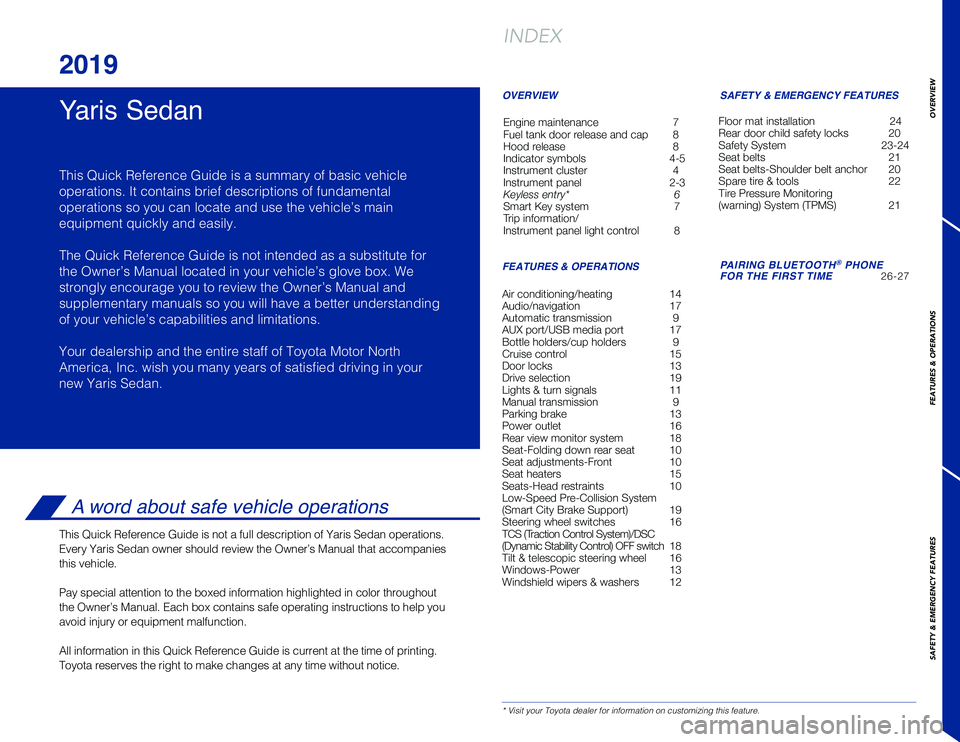
1
* Visit your Toyota dealer for information on customizing this feature.
Yaris Sedan
2019
This Quick Reference Guide is a summary of basic vehicle
operations. It contains brief descriptions of fundamental
operations so you can locate and use the vehicle’s main
equipment quickly and easily.
The Quick Reference Guide is not intended as a substitute for
the Owner’s Manual located in your vehicle’s glove box. We
strongly encourage you to review the Owner’s Manual and
supplementary manuals so you will have a better understanding
of your vehicle’s capabilities and limitations.
Your dealership and the entire staff of Toyota Motor North
America, Inc. wish you many years of satisfied driving in your
new Yaris Sedan.
A word about safe vehicle operations
This Quick Reference Guide is not a full description of Yaris Sedan oper\
ations.
Every Yaris Sedan owner should review the Owner’s Manual that accompa\
nies
this vehicle.
Pay special attention to the boxed information highlighted in color throughout
the Owner’s Manual. Each box contains safe operating instructions to \
help you
avoid injury or equipment malfunction.
All information in this Quick Reference Guide is current at the time of \
printing.
Toyota reserves the right to make changes at any time without notice.
INDEX
Engine maintenance 7Fuel tank door release and cap 8Hood release 8Indicator symbols 4-5Instrument cluster 4Instrument panel 2-3Keyless entry* 6Smart Key system 7Trip information/ Instrument panel light control 8
OVERVIEW
FEATURES & OPERATIONS
SAFETY & EMERGENCY FEATURES
PAIRING BLUETOOTH® PHONEFOR THE FIRST TIME 26-27
Air conditioning/heating 14Audio/navigation 17Automatic transmission 9AUX port/USB media port 17Bottle holders/cup holders 9Cruise control 15Door locks 13Drive selection 19 Lights & turn signals 11Manual transmission 9Parking brake 13Power outlet 16Rear view monitor system 18Seat-Folding down rear seat 10Seat adjustments-Front 10Seat heaters 15 Seats-Head restraints 10 Low-Speed Pre-Collision System (Smart City Brake Support) 19Steering wheel switches 16TCS (Traction Control System)/DSC (Dynamic Stability Control) OFF switch 18Tilt & telescopic steering wheel 16Windows-Power 13Windshield wipers & washers 12
Floor mat installation 24Rear door child safety locks 20Safety System 23-24Seat belts 21Seat belts-Shoulder belt anchor 20Spare tire & tools 22Tire Pressure Monitoring(warning) System (TPMS) 21
OVERVIEW
FEATURES & OPERATIONS
SAFETY
& EMERGENCY FEATURES
Page 3 of 17
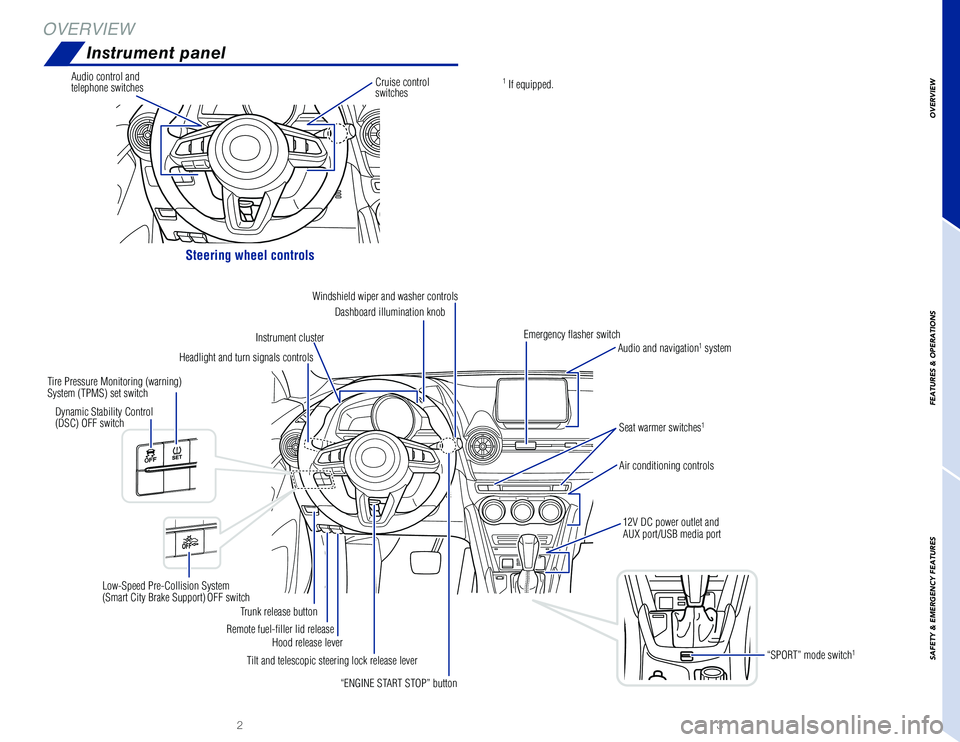
32
OVERVIEW
FEATURES & OPERATIONS
SAFETY
& EMERGENCY FEATURES
OVERVIEW
Instrument panel
Steering wheel controls
Headlight and turn signals controls
Instrument cluster
Trunk release button
Remote fuel-filler lid release
Audio and navigation1 system
Emergency flasher switch
Dashboard illumination knob
Air conditioning controls
Seat warmer switches1
“SPORT” mode switch1
12V DC power outlet and AUX port/USB media port
Windshield wiper and washer controls
“ENGINE START STOP” button
Hood release lever
Tilt and telescopic steering lock release lever
Dynamic Stability Control (DSC) OFF switch
Low-Speed Pre-Collision System (Smart City Brake Support) OFF switch
Tire Pressure Monitoring (warning) System (TPMS) set switch
Audio control and telephone switchesCruise control switches
1 If equipped.
Page 4 of 17
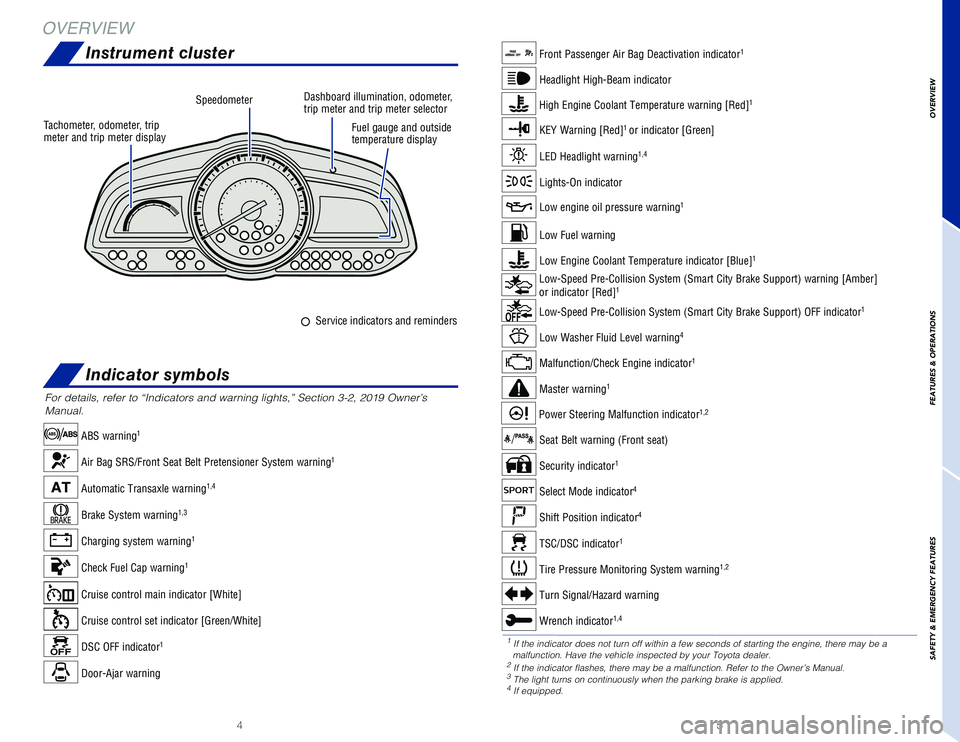
54
OVERVIEW
FEATURES & OPERATIONS
SAFETY
& EMERGENCY FEATURES
OVERVIEW
Instrument cluster
Indicator symbols
For details, refer to “Indicators and warning lights,” Section 3-2, 2019 Owner’s
Manual.
High Engine Coolant Temperature warning [Red]1
Master warning1
Charging system warning1
Brake System warning1,3
ABS warning1
Malfunction/Check Engine indicator1
Power Steering Malfunction indicator1,2
Air Bag SRS/Front Seat Belt Pretensioner System warning1
Automatic Transaxle warning1,4
Low engine oil pressure warning1
Check Fuel Cap warning1
Seat Belt warning (Front seat)
Low-Speed Pre-Collision System (Smart City Brake Support) warning [Amb\
er]
or indicator [Red]1
Low-Speed Pre-Collision System (Smart City Brake Support) OFF indicator1
Tire Pressure Monitoring System warning1,2
KEY Warning [Red]1 or indicator [Green]
Low Washer Fluid Level warning4
Low Fuel warning
Wrench indicator1,4
Low Engine Coolant Temperature indicator [Blue]1
TSC/DSC indicator1
DSC OFF indicator1
Security indicator1
Shift Position indicator4
Turn Signal/Hazard warning
Select Mode indicator4
Lights-On indicator
LED Headlight warning1,4
Front Passenger Air Bag Deactivation indicator1
Cruise control set indicator [Green/White]
Cruise control main indicator [White]
Headlight High-Beam indicator
Door-Ajar warning
1 If the indicator does not turn off within a few seconds of starting the \
engine, there may be a malfunction. Have the vehicle inspected by your Toyota dealer.2 If the indicator flashes, there may be a malfunction. Refer to the Owner\
’s Manual.3 The light turns on continuously when the parking brake is applied.4 If equipped.
SpeedometerDashboard illumination, odometer, trip meter and trip meter selector
Tachometer, odometer, trip meter and trip meter display Fuel gauge and outsidetemperature display
Service indicators and reminders
Page 5 of 17

76
OVERVIEW
FEATURES & OPERATIONS
SAFETY
& EMERGENCY FEATURES
UNLOCKING OPERATION
PANIC BUTTON
TRUNK BUTTON
LOCKING OPERATION
Keyless entry (if equipped)Smart Key system
OVERVIEW
NOTE: If a door is not opened within 60 seconds of unlocking, all doors will
relock for safety.
Push
Push and hold
PushONCE: Driver doorTWICE: All doors
Push and hold
Without depressing the brake pedal, pressing the engine switch will chan\
ge the
operation mode in succession from:
Accessory – Some electrical components can be used.
On - All electrical components can be used.
Off - All systems OFF. Emergency flashers can be used.
POWER (WITHOUT STARTING ENGINE)
NOTE: The Smart Key must be carried to enable the start function. With gear
shift lever in Park and the brake pedal depressed (automatic transmission)/
with the gear shift lever in N and the clutch pedal depressed (manual
transmission), push the “ENGINE START STOP” switch.
ACCESSORY
ON
OFF
Engine maintenance
NOTE: Regularly scheduled maintenance, including oil changes, will help
extend the life of your vehicle and maintain performance. Please refer to the
“Warranty Maintenance Guide.”
Windshield washer fluid tank
Engine oil level dipstickEngine oil-filler cap
Engine coolant reservoir
Engine coolant cap
Carry Smart Key remote
Push
Request switch
All-door lock
Carry Smart Key remote
Push
Request switch
Page 6 of 17
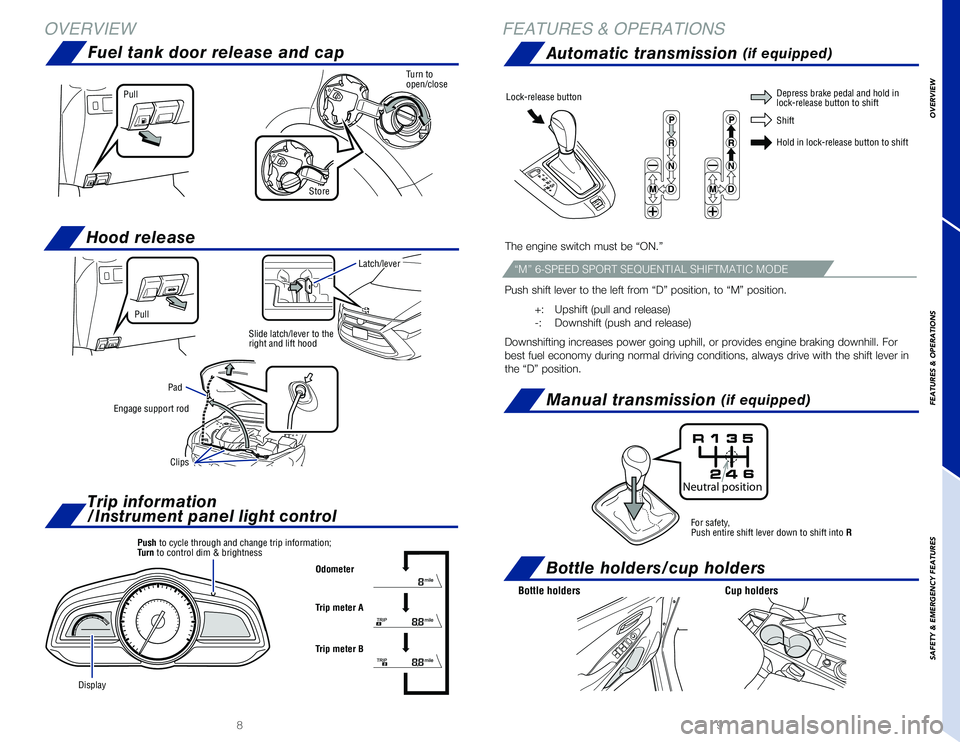
98
OVERVIEW
FEATURES & OPERATIONS
SAFETY
& EMERGENCY FEATURES
Fuel tank door release and cap
Pull
Turn to open/close
Store
OVERVIEW
Hood release
Automatic transmission (if equipped)
Manual transmission (if equipped)
Bottle holders/cup holders
Push shift lever to the left from “D” position, to “M” posit\
ion.
+: Upshift (pull and release)
-: Downshift (push and release)
Downshifting increases power going uphill, or provides engine braking do\
wnhill. For
best fuel economy during normal driving conditions, always drive with th\
e shift lever in
the “D” position.
The engine switch must be “ON.”
Depress brake pedal and hold in lock-release button to shift
Shift
Hold in lock-release button to shift
“M” 6-SPEED SPORT SEQUENTIAL SHIFTMATIC MODE
Trip information
/Instrument panel light control
Push to cycle through and change trip information;Turn to control dim & brightness
Display
Odometer
Trip meter A
Trip meter B
Pull
Latch/lever
Pad
Clips
Slide latch/lever to the right and lift hood
Engage support rod
FEATURES & OPERATIONS
Neutral po sition
Lock-release button
Cup holdersBottle holders
For safety,Push entire shift lever down to shift into R
Page 9 of 17
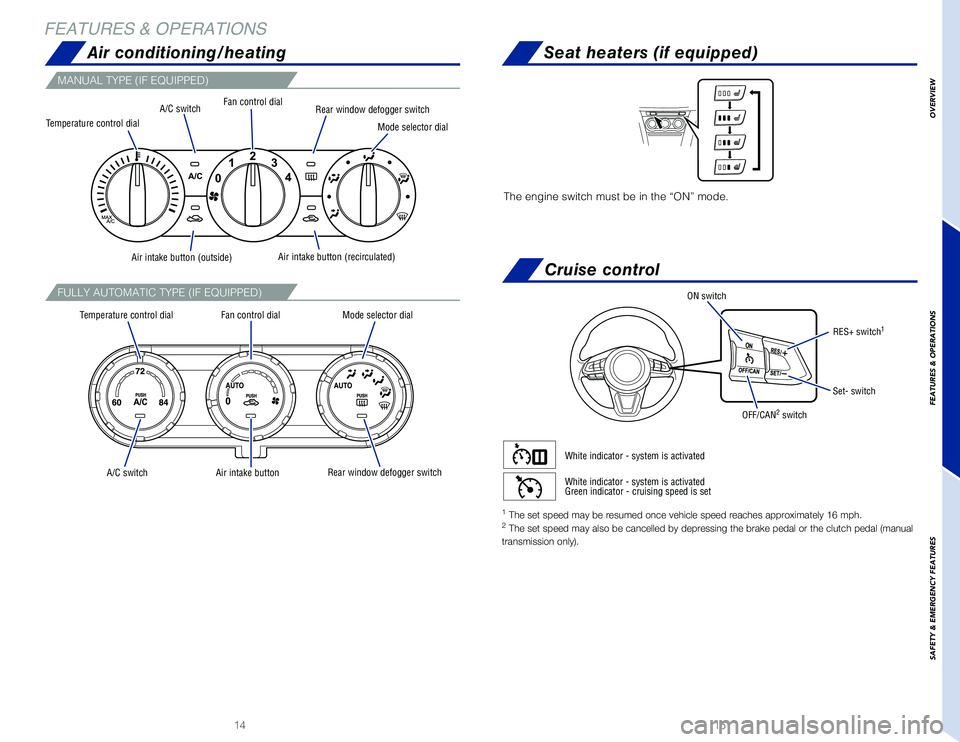
1514
OVERVIEW
FEATURES & OPERATIONS
SAFETY
& EMERGENCY FEATURES
FEATURES & OPERATIONS
The engine switch must be in the “ON” mode.
Seat heaters (if equipped)
MANUAL TYPE (IF EQUIPPED)
FULLY AUTOMATIC TYPE (IF EQUIPPED)
Temperature control dialMode selector dial
Air intake buttonA/C switchRear window defogger switch
Fan control dial
Air conditioning/heating
Temperature control dialMode selector dial
Air intake button (outside)Air intake button (recirculated)
A/C switchRear window defogger switchFan control dial
Cruise control
ON switch
Set- switch
RES+ switch1
OFF/CAN2 switch
1 The set speed may be resumed once vehicle speed reaches approximately 16\
mph.2 The set speed may also be cancelled by depressing the brake pedal or th\
e clutch pedal (manual
transmission only).
White indicator - system is activatedGreen indicator - cruising speed is set
White indicator - system is activated
Page 11 of 17
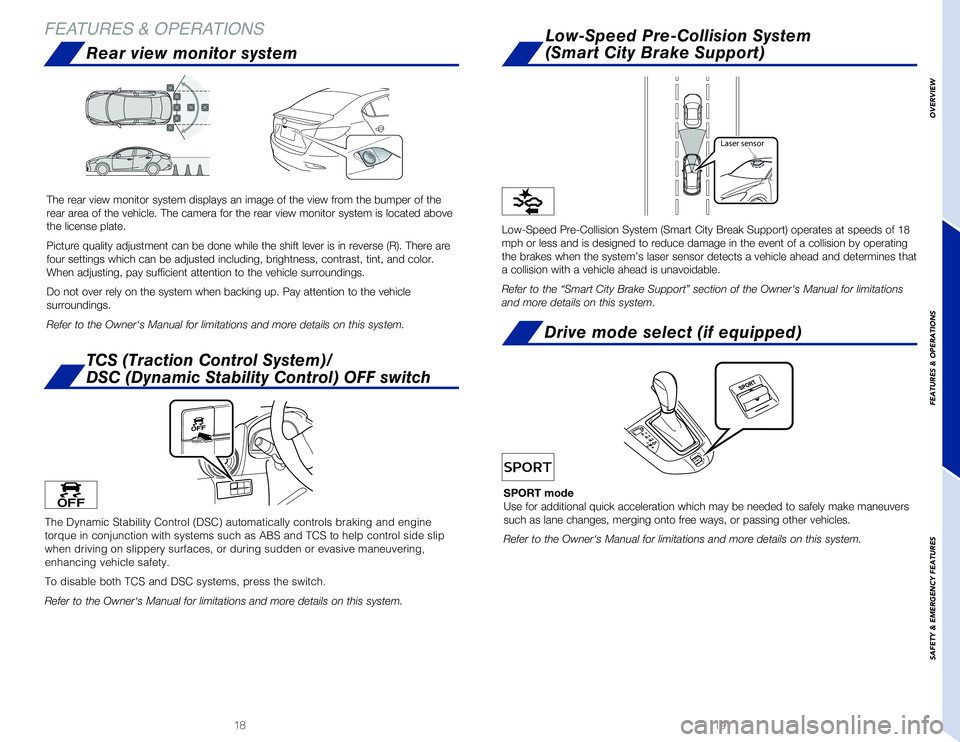
1918
OVERVIEW
FEATURES & OPERATIONS
SAFETY
& EMERGENCY FEATURES
FEATURES & OPERATIONS
The Dynamic Stability Control (DSC) automatically controls braking and\
engine
torque in conjunction with systems such as ABS and TCS to help control s\
ide slip
when driving on slippery surfaces, or during sudden or evasive maneuveri\
ng,
enhancing vehicle safety.
To disable both TCS and DSC systems, press the switch.
Refer to the Owner‘s Manual for limitations and more details on this \
system.
Low-Speed Pre-Collision System (Smart City Break Support) operates at \
speeds of 18
mph or less and is designed to reduce damage in the event of a collision\
by operating
the brakes when the system’s laser sensor detects a vehicle ahead and\
determines that
a collision with a vehicle ahead is unavoidable.
Refer to the “Smart City Brake Support” section of the Owner‘s \
Manual for limitations
and more details on this system.
SPORT mode
Use for additional quick acceleration which may be needed to safely make\
maneuvers
such as lane changes, merging onto free ways, or passing other vehicles.\
Refer to the Owner‘s Manual for limitations and more details on this \
system.
Laser sensor
Low-Speed Pre-Collision System
(Smart City Brake Support)
Drive mode select (if equipped)
TCS (Traction Control System)/
DSC (Dynamic Stability Control) OFF switch
The rear view monitor system displays an image of the view from the bump\
er of the
rear area of the vehicle. The camera for the rear view monitor system is\
located above
the license plate.
Picture quality adjustment can be done while the shift lever is in rever\
se (R). There are
four settings which can be adjusted including, brightness, contrast, tin\
t, and color.
When adjusting, pay sufficient attention to the vehicle surroundings.
Do not over rely on the system when backing up. Pay attention to the veh\
icle
surroundings.
Refer to the Owner‘s Manual for limitations and more details on this \
system.
Rear view monitor system
Page 13 of 17
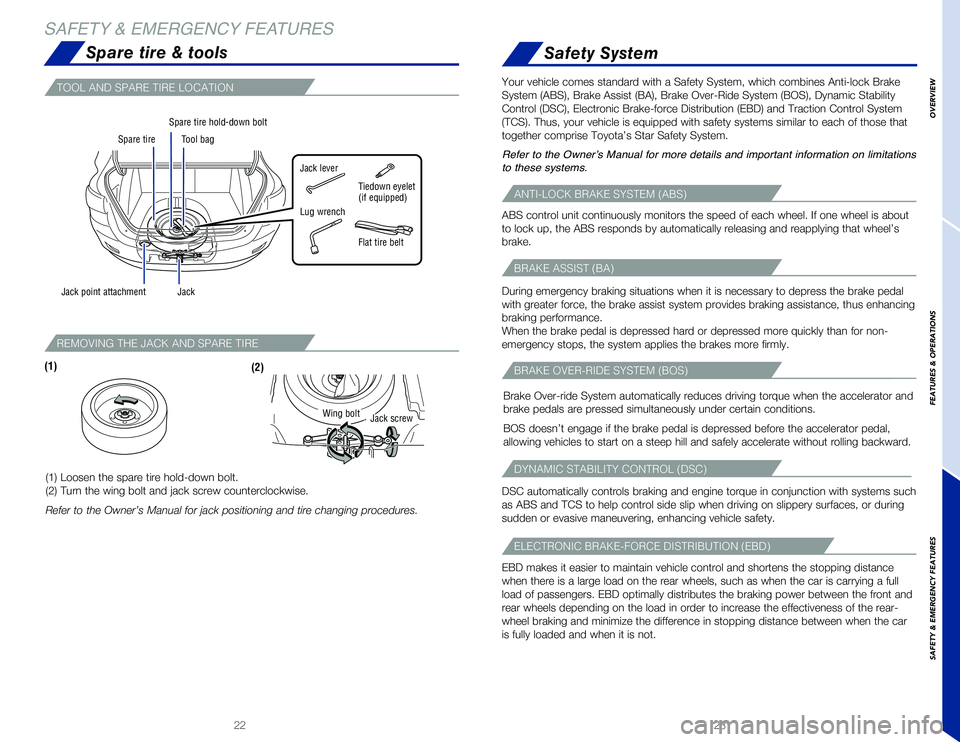
2322
OVERVIEW
FEATURES & OPERATIONS
SAFETY
& EMERGENCY FEATURES
SAFETY & EMERGENCY FEATURES
Spare tire & tools
Spare tire
Flat tire belt
Spare tire hold-down bolt
Lug wrench
Tool bag
Jack
Jack lever
Jack point attachment
Tiedown eyelet(if equipped)
(1) Loosen the spare tire hold-down bolt.
(2) Turn the wing bolt and jack screw counterclockwise.
Refer to the Owner’s Manual for jack positioning and tire changing pr\
ocedures.
Wing boltJack screw
(1)(2)
REMOVING THE JACK AND SPARE TIRE
Safety System
Your vehicle comes standard with a Safety System, which combines Anti-lo\
ck Brake
System (ABS), Brake Assist (BA), Brake Over-Ride System (BOS), Dyn\
amic Stability
Control (DSC), Electronic Brake-force Distribution (EBD) and Tractio\
n Control System
(TCS). Thus, your vehicle is equipped with safety systems similar to e\
ach of those that
together comprise Toyota’s Star Safety System.
Refer to the Owner’s Manual for more details and important informatio\
n on limitations
to these systems.
DSC automatically controls braking and engine torque in conjunction with\
systems such
as ABS and TCS to help control side slip when driving on slippery surfac\
es, or during
sudden or evasive maneuvering, enhancing vehicle safety.
DYNAMIC STABILITY CONTROL (DSC)
ABS control unit continuously monitors the speed of each wheel. If one w\
heel is about
to lock up, the ABS responds by automatically releasing and reapplying t\
hat wheel’s
brake.
ANTI-LOCK BRAKE SYSTEM (ABS)
During emergency braking situations when it is necessary to depress the \
brake pedal
with greater force, the brake assist system provides braking assistance,\
thus enhancing
braking performance.
When the brake pedal is depressed hard or depressed more quickly than fo\
r non-
emergency stops, the system applies the brakes more firmly.
BRAKE ASSIST (BA)
EBD makes it easier to maintain vehicle control and shortens the stoppin\
g distance
when there is a large load on the rear wheels, such as when the car is c\
arrying a full
load of passengers. EBD optimally distributes the braking power between \
the front and
rear wheels depending on the load in order to increase the effectiveness\
of the rear-
wheel braking and minimize the difference in stopping distance between w\
hen the car
is fully loaded and when it is not.
ELECTRONIC BRAKE-FORCE DISTRIBUTION (EBD)
Brake Over-ride System automatically reduces driving torque when the acc\
elerator and
brake pedals are pressed simultaneously under certain conditions.
BOS doesn’t engage if the brake pedal is depressed before the acceler\
ator pedal,
allowing vehicles to start on a steep hill and safely accelerate without\
rolling backward.
BRAKE OVER-RIDE SYSTEM (BOS)
TOOL AND SPARE TIRE LOCATION
Page 14 of 17
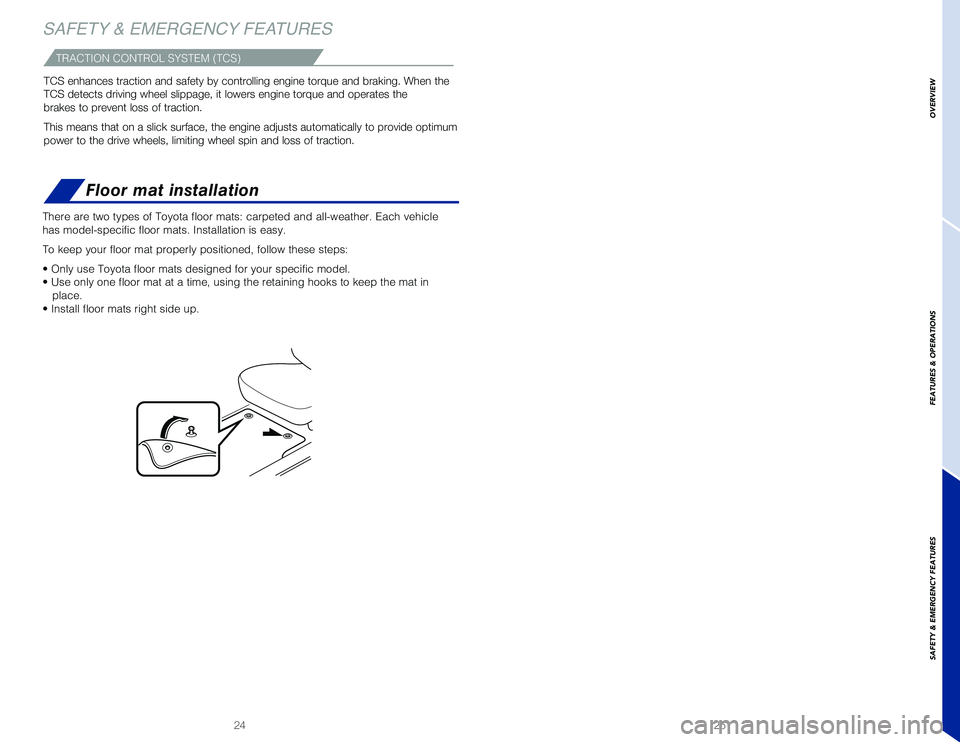
2524
OVERVIEW
FEATURES & OPERATIONS
SAFETY
& EMERGENCY FEATURES
SAFETY & EMERGENCY FEATURES
Floor mat installation
There are two types of Toyota floor mats: carpeted and all-weather. Each\
vehicle
has model-specific floor mats. Installation is easy.
To keep your floor mat properly positioned, follow these steps:
• Only use Toyota floor mats designed for your specific model.
• Use only one floor mat at a time, using the retaining hooks to keep\
the mat in
place.
• Install floor mats right side up.
TCS enhances traction and safety by controlling engine torque and brakin\
g. When the
TCS detects driving wheel slippage, it lowers engine torque and operates\
the
brakes to prevent loss of traction.
This means that on a slick surface, the engine adjusts automatically to \
provide optimum
power to the drive wheels, limiting wheel spin and loss of traction.
TRACTION CONTROL SYSTEM (TCS)